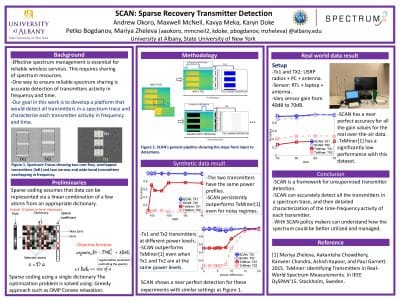Authors
Blessing Okoro, Maxwell McNeil, Kavya Meka, Karyn Doke, Petko Bogdanov, Mariya Zheleva
Abstract
Transmitter detection and separation in radio spectrum scans is an essential component in emerging spectrum-sharing networks, as it underpins coexistence and spectrum enforcement. Detecting transmitters in noisy real-world traces, however, is challenging and has been tackled with limited practical applicability. Beyond noisy measurements, the challenges stem from the need to simultaneously detect multiple and possibly overlapping transmitters' frequency bands and track their transmissions over time.
We address the above challenges by proposing SCAN (underline{S}parse reunderline{C}overy trunderline{A}nsmitter detectiounderline{N}): an unsupervised approach based on sparse dictionary coding to detect both the frequency band and the temporal behavior of multiple co-occurring transmitters from raw spectrum scans. We demonstrate SCAN's applicability to high-noise regimes and across various transmitter co-occurrence scenarios, including when transmitters concurrently overlap in time and frequency (akin intentional or unintentional interference). We evaluate SCAN's performance across challenging synthetic and real-world traces and in comparison with baselines. We show that SCAN can characterize multiple transmitters even when their power levels are the same. Furthermore, SCAN successfully detects and characterizes 10 simultaneously observed transmitters, whereas counterparts fall short even in 3-transmitter scenarios.

